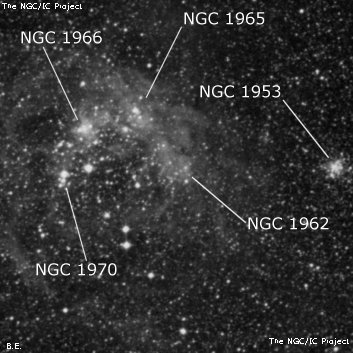
Adding a UHC filter provided an excellent contrast gain to the bright nebulosity. The entire complex is part of a Superbubble. NGC 1953, an LMC open cluster, lies 4.5' W and a large number of additional clusters that I didn't have time to explore lie to the south and southeast.
John Herschel discovered NGC 1962 = h2866 on 31 Jan 1835 and recorded "vF, pL, R; the first of a group of 4 nebulae [NGC 1962, 1965, 1966, 1970] with stars. (N.B. The mirror newly polished. See fig 20, Plate VI.)" His sketch (Plate VI, figure 20) clearly identifies all 4 nebulae in the group. James Dunlop discovered the entire group (D 136 = S-L 476) and described "a faint confused pretty large nebula. There are a multitude of small nebulae in this place." His position is ~10' too far SW (typical error), though he did not distinguish individual components.
Joseph Turner sketched the entire group in Dec 1875 using the 48" Great Melbourne Telescope (plate III, figure 30 at www.docdb.net/history/texts/1885osngmt________e/lithograph_m_3_30.php). The sketch shows NGC 1962 as two connected pieces with a few stars involved. Pietro Baracchi also sketched a patch directly between NGC 1962 and 1965 on 18 Nov 1884.
600/800mm - 24" (4/7/08 - Magellan Observatory, Australia): NGC 1962 forms the bright western patch of the NGC 1962-65-66-70 cluster and emission nebula (stellar association LH 58). At 200x it appeared as a large, fairly bright glow on the west side of the complex, ~2' in diameter. A few faint stars are peppered across the glow. At the E end is mag 12.3 HD 36521 = Brey 32, a WC4-type Wolf-Rayet binary.
Notes by Steve Gottlieb